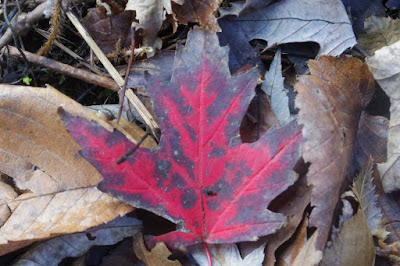On Wednesday, November 8th, I was one of several members of the Grand Island Conservation Advisory Board to join Kathleen McCormick of the Western New York Land Conservancy in walking through two town-owned pieces of property, which are maintained as “forever wild.” One of the properties was in the southern portion of Grand Island, and the other one was more to the northeast. We went to look for such things as invasive plant species and tree species.
The mission of the Western New York Land Conservancy is to permanently protect land with significant conservation value for future generations. This includes wetlands, forests, farmland, meadows, creeks, marshes, grasslands, and more.
In the southern Grand Island property, as we entered, we found several invasive plant species, which includes periwinkle (also known as vinca minor) and buckthorn.
Perwinkle is invasive but it isn’t especially harmful. It was brought to the United States from Europe in the 1700s. It produces “a pretty blue flower in the spring,” Kathleen said. It grows in clumps and is considered to be good ground cover. “It can’t be sold now, but it has been sold as a landscape plant for years,” Kathleen said.
It will grow in just about every soil type, and it spreads dramatically. Because it spreads so much, it is considered to be invasive.
Buckthorn was introduced to the United States in the 1800s. It was sold as hedges, although buckthorn can be shrubs or small trees. Not long after buckthorn was introduced to the United States, it was found to be an invasive species, and, in the 1930s, nurseries stopped selling it. Buckthorn is especially invasive in wetlands, and, because it is not a native species, there are few, if any insect or animal species to keep its growth from going out of control. It propagates itself with the help of the wind, as the seeds get scattered.
We noticed something that looked as if it might have, at one time, been a trail. It could have been a farm road or a deer path or, quite possibly, wagon wheels came through the area.
Here we noticed a variety of trees, including shagbark hickory and eastern hophornbeam.
In the other property, which runs along Gun Creek, Kathleen and I discussed tree species there. We observed that there was mostly oak, maple, hickory, beech, and some ash.
In both locations, there were also interesting looking mushrooms and other
fungi growing on tree trunks that had long ago fallen to the ground.
It was a sunny day, but it had rained quite a bit, and both properties were very wet. The ditches resembled creeks.
Despite the dampness and the full creeks that needed to be crossed on foot, it was a good experience, and I learned a lot of interesting things about wild Grand Island.









Loved these photos. It took me back to walks taken in what we call "the bush" out of town. Wet, mushy foliage underfoot. Long twisty twigs that whipped back after we pushed them out the way. Dogs racing ahead and running back to meet us. Wonderful days. How to Be Part of a Powerful Street Team
I loved the photos, too.
But, an invasive species is not so named because it grows so much- but because it overcomes the native species (not just of vegetation, but it could be harming the animal and/or insect ecosystem) and lacks a predator to keep it in check.
I especially loved the pictures of the leaves! And it was neat to see the *color* periwinkle, too. 🙂